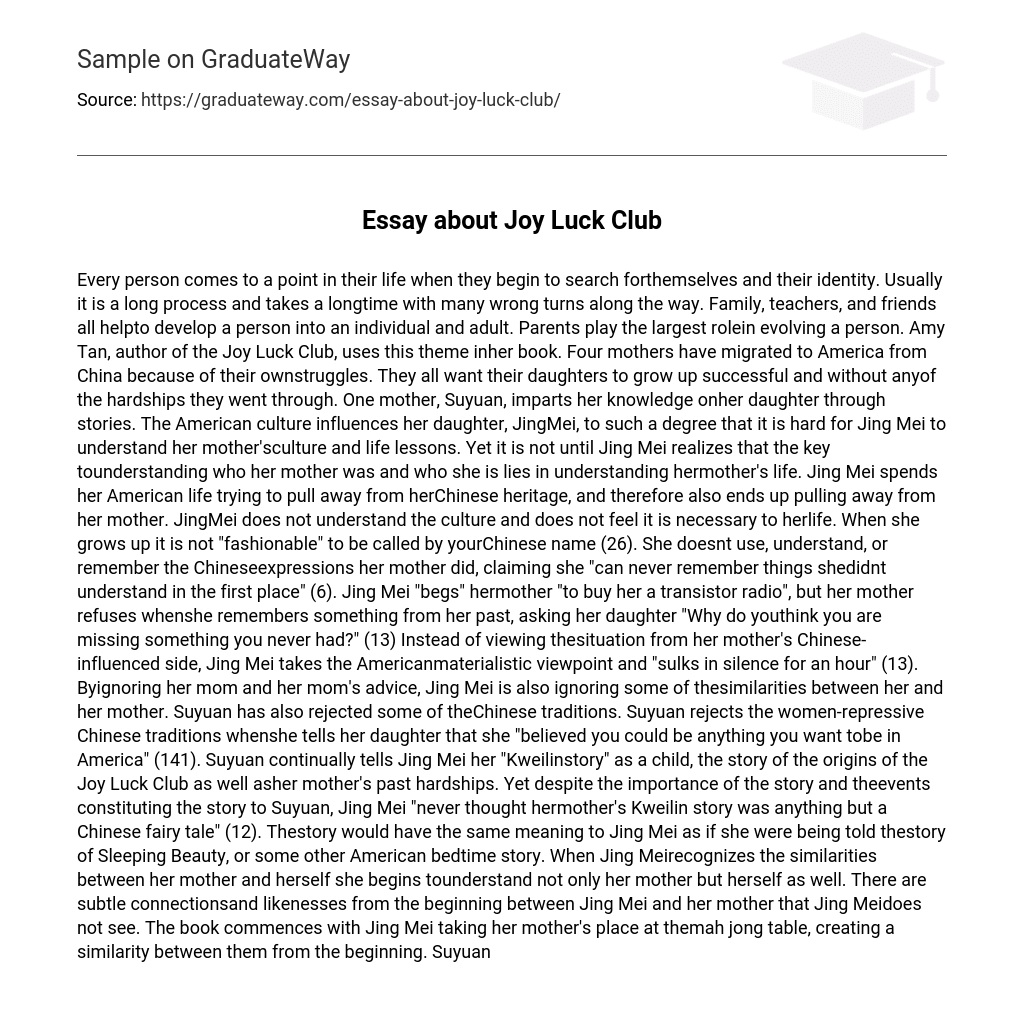Every person comes to a point in their life when they begin to search forthemselves and their identity. Usually it is a long process and takes a longtime with many wrong turns along the way. Family, teachers, and friends all helpto develop a person into an individual and adult. Parents play the largest rolein evolving a person. Amy Tan, author of the Joy Luck Club, uses this theme inher book. Four mothers have migrated to America from China because of their ownstruggles. They all want their daughters to grow up successful and without anyof the hardships they went through. One mother, Suyuan, imparts her knowledge onher daughter through stories. The American culture influences her daughter, JingMei, to such a degree that it is hard for Jing Mei to understand her mother’sculture and life lessons. Yet it is not until Jing Mei realizes that the key tounderstanding who her mother was and who she is lies in understanding hermother’s life. Jing Mei spends her American life trying to pull away from herChinese heritage, and therefore also ends up pulling away from her mother. JingMei does not understand the culture and does not feel it is necessary to herlife. When she grows up it is not “fashionable” to be called by yourChinese name (26). She doesnt use, understand, or remember the Chineseexpressions her mother did, claiming she “can never remember things shedidnt understand in the first place” (6). Jing Mei “begs” hermother “to buy her a transistor radio”, but her mother refuses whenshe remembers something from her past, asking her daughter “Why do youthink you are missing something you never had?” (13) Instead of viewing thesituation from her mother’s Chinese-influenced side, Jing Mei takes the Americanmaterialistic viewpoint and “sulks in silence for an hour” (13). Byignoring her mom and her mom’s advice, Jing Mei is also ignoring some of thesimilarities between her and her mother. Suyuan has also rejected some of theChinese traditions. Suyuan rejects the women-repressive Chinese traditions whenshe tells her daughter that she “believed you could be anything you want tobe in America” (141). Suyuan continually tells Jing Mei her “Kweilinstory” as a child, the story of the origins of the Joy Luck Club as well asher mother’s past hardships. Yet despite the importance of the story and theevents constituting the story to Suyuan, Jing Mei “never thought hermother’s Kweilin story was anything but a Chinese fairy tale” (12). Thestory would have the same meaning to Jing Mei as if she were being told thestory of Sleeping Beauty, or some other American bedtime story. When Jing Meirecognizes the similarities between her mother and herself she begins tounderstand not only her mother but herself as well. There are subtle connectionsand likenesses from the beginning between Jing Mei and her mother that Jing Meidoes not see. The book commences with Jing Mei taking her mother’s place at themah jong table, creating a similarity between them from the beginning. Suyuandies two months before the start of the book, and therefore is not able to tellthe stories. Jing Mei has learned and must tell her stories in her place,forming another parallelism between mother and daughter. Because Suyuan is dead,Jing Mei must act in place of her mother when she goes to meet her Chinesesisters in China. Throughout the book Jing Mei takes the place of Suyuan,showing she and her mother have a unique link even with the barrier of theliving world. Jing Mei finally begins to realize her identity and past when shetravels in place of her mother to China to meet her two twin sisters. Suyuan hadto make the hard decision to leave her twin babies on the side of the road inhopes some kind stranger would take them in, that way she would not have to seethem die. Suyuan searches for her babies all through her life in America,sending multitudes of letters; they finally get in touch with her two monthsafter she has died. Because her mother is not alive to meet her children, JingMei takes her place and the trip enables her to finally recognize her Chineseancestry. The minute she enters China she “feels different” and canrealize that she is “becoming Chinese” (306). At fifteen Jing Meibelieved she was only as Chinese as her “Caucasian friends” (306). Yether mother counters thoughts, telling her: “Once you are born Chinese, youcannot help but feel and think Chinese” (306). Once in China Jing Meidecides her mother was right and she “has never really known what it meantto be Chinese” (307). She has never understood her mother or her heritage.
This trip is the connecting link to understanding her life. She begins to feelnatural in China, thinking to herself on the train: “I am in China Itfeels right” (312). Jing Mei sees the landscape, the people, the histories,and the families in China and sees where her mother was speaking from all ofthose years. She knows a “little percent” of her mother know (15). Itbecomes “obvious” to Jing Mei to see what “part of her isChinese”; it is “in her family, in her blood” (331). Jing Meifinally realizes herself when she travels to China, trying to connect with hermother and searching for her identity. The longer she stays in China, the moreconnected Jing Mei feels to her mother, the more she feels at home, and the moreshe understands what her mother was trying to teach her. At last when Jing Meiembraces her sisters for the first time at the airport, and they look at thePolaroid so view their similarities, Jing Mei realizes the part of her that isChinese is her family. She must embrace the memory of her dead mother to graspthat part of her identity.
English Essays





